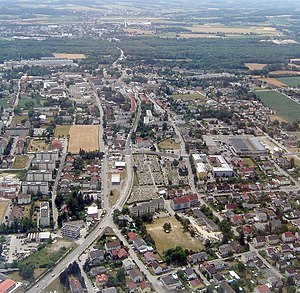Traun
| Traun | ||
|---|---|---|

Traun panorama
|
||
|
||
| Location within Austria | ||
| Coordinates: 48°13′18″N 14°14′23″E / 48.22167°N 14.23972°ECoordinates: 48°13′18″N 14°14′23″E / 48.22167°N 14.23972°E | ||
| Country | Austria | |
| State | Upper Austria | |
| District | Linz-Land | |
| Government | ||
| • Mayor | Rudolf Scharinger (SPÖ) | |
| Area | ||
| • Total | 15.49 km2 (5.98 sq mi) | |
| Elevation | 273 m (896 ft) | |
| Population (14 June 2016) | ||
| • Total | 24,058 | |
| • Density | 1,600/km2 (4,000/sq mi) | |
| Time zone | CET (UTC+1) | |
| • Summer (DST) | CEST (UTC+2) | |
| Postal code | 4050 | |
| Area code | 07229 | |
| Vehicle registration | LL | |
| Website | www.traun.at | |
Traun [ˈtʀaʊ̯n] (![]() Pronunciation ) is an Austrian city located on the north bank of the river Traun and borders Linz, the capital of Upper Austria, to the east. The name Traun is derived from the Celtic word for river (dru). Traun is the fifth largest city in Upper Austria, located in the district of Linz-Land.
Pronunciation ) is an Austrian city located on the north bank of the river Traun and borders Linz, the capital of Upper Austria, to the east. The name Traun is derived from the Celtic word for river (dru). Traun is the fifth largest city in Upper Austria, located in the district of Linz-Land.
Neolithic: Excavation findings suggest that the first settlements date to when the Roman road led from Wels to (Enns).
6th century: Bavarii settle in the area of Traun.
about 790: The name dru appears on a document for the first time.
about 813 to 824: First mentioning as a place in a document.
1113: First evidence of the former moated castle.
1560: Reconstruction of the castle into a Renaissance building.
1725: Reconstruction of the castle into a Baroque building.
1784: First school in Traun opens.
1785: Fusion with the villages of St. Dionysen and Oedt.
about 1850: First industries: Enderlin, Berl and Graumann brothers (textiles), Dr. Feurstein (paper), Gabler (flat and braid products), Enenkel (vinegar factory).
1851: Inauguration of the first Protestant school.
1876: The St. Martin district transferred from the community of Kleinmünchen to Traun.
1882: Construction of the Catholic parish church.
1884: The owner of the castle (count Abensperg-Traun) moves back to the estates in Lower Austria.
1913: Inauguration of the Protestant church.
1915: Inauguration of the new Protestant school.
1965: Lake Oedter See begins to be used for bathing.
1973: Traun, the 'biggest village of Austria' is elevated to a city. The Bundesschulzentrum Traun (home of the 2 high schools Bundesrealgymnasium and Handelsakademie) opens. The building's modern design served as model for schools in the 70s.
1975: The bathing center (Badezentrum) opens with two indoor swimming pools with a sauna and restaurant. Later extended to include an open-air pool, a lawn for sunbathing and an ice-skating rink.
1979: The sports center and stadium (HAKA-Arena) opens.
1982: Firefighters and red cross-center as well as Telegraph office open.
1985: Opening of the New City Hall and the City Gallery.
1991: Introduction of the City Buses.
1997: The new B139 (bypass road) is finished and the Spinnerei (a cultural center for youths) opens.
1999: Redesign of the main square, new ice-skating rink and renovation of the bathing center.
2002: The high school HTL-Traun (Höhere technische Lehranstalt) opens, starting in a provisional building.
2005: Opening of the Traun District Court.
2012: The new building housing the HTL-Traun high school opens.
...
Wikipedia


